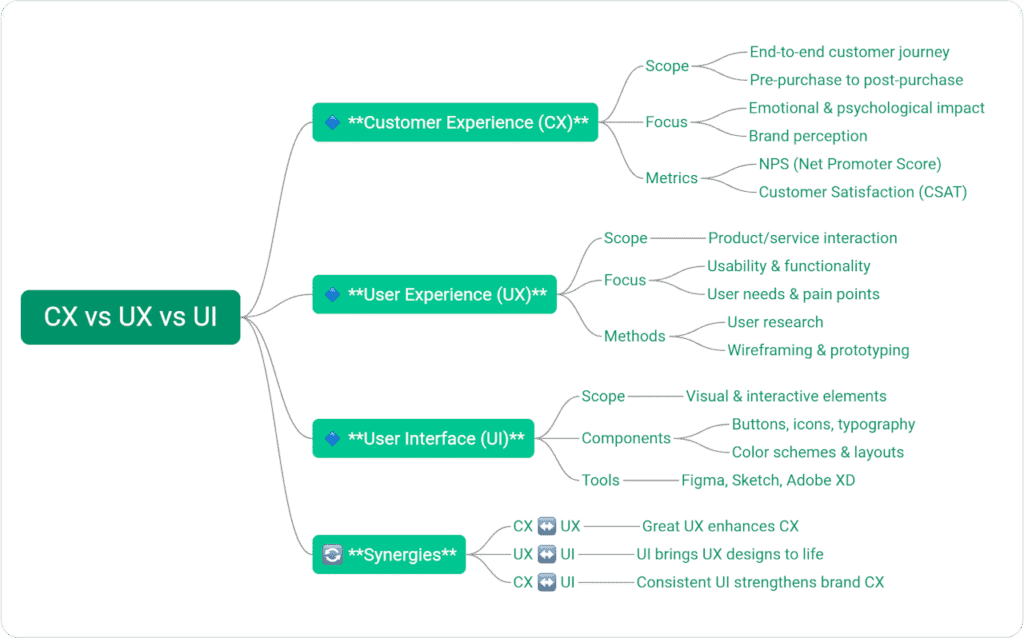Mastering the Unique Functions of Customer Experience (CX), User Experience (UX), and User Interface (UI) in Your Digital Marketing Approach
In the ever-evolving realm of digital marketing, the terms CX, UX, and UI are often mistakenly viewed as synonymous. Yet, each of these concepts represents a distinct area of expertise, contributing significantly to how brands engage with their customers. A comprehensive understanding of these individual elements, their interrelations, and their strategic importance is crucial for businesses aiming to provide outstanding digital experiences. This article explores the meanings of CX, UX, and UI from a UK viewpoint, offering valuable insights to brands like EZi Gold for making informed design and strategy decisions that resonate deeply with their intended audience.
The Integral Importance of CX, UX, and UI in a Competitive Digital Environment

Customer Experience (CX): A Comprehensive Overview of Brand Interactions
Customer Experience, commonly referred to as CX, embodies the overall and holistic perception that a customer formulates regarding a brand through numerous interactions, touchpoints, and communication channels. CX extends beyond mere usability or attractive design; it encapsulates the entire emotional and functional journey that customers embark upon. This journey includes critical aspects such as the quality of customer service, the effectiveness of digital engagement, the efficiency of product delivery, and the nature of support interactions, all of which contribute to the overall perception of the brand.
In the UK, where consumer expectations are exceptionally high, businesses need to ensure that each interaction is crafted to be both purposeful and positive, leaving an enduring impression on customers. For EZi Gold, this entails synchronising marketing communications seamlessly with website design, post-purchase support, and ongoing brand engagement strategies to cultivate a consistent and customer-centric experience throughout the entire customer journey.
User Experience (UX): Optimising User Interactions for Maximum Satisfaction
User Experience, often abbreviated as UX, specifically focuses on how users interact with a product or service, particularly within digital environments. It involves various elements such as usability, workflow, navigation, and the overall satisfaction users derive from their digital experiences. A thoughtfully designed UX streamlines tasks, making information easily accessible, which reduces friction and significantly enhances user engagement.
When evaluating a website or application, UX plays a pivotal role in determining how effortlessly users can navigate the platform to complete tasks, whether that involves locating contact information, finalising a purchase, or exploring different resources. High-quality UX design is inherently data-driven, informed by user research and iterative testing, ensuring it effectively meets user needs and expectations.
User Interface (UI): Designing Visually Appealing and Functional Interfaces

User Interface, or UI, includes all visual and interactive components of a product or system. It encompasses every aspect that users can see, touch, and engage with, such as buttons, typography, colour schemes, and layout designs. Effective UI is crucial in influencing the overall UX by ensuring that interfaces are not only visually appealing but also coherent and consistent. It is important to recognise that UI does not replace UX; rather, they serve complementary roles.
For example, while UX may indicate the necessity for an effective call-to-action (CTA) in a specific location on a webpage, UI is responsible for decisions regarding the placement, colour, font choice, and any animations associated with that CTA. In the case of EZi Gold, strategic UI design choices can substantially influence how modern, intuitive, and accessible the brand appears to potential clients and users, ultimately shaping their overall perceptions and interactions.
Harmonising CX, UX, and UI for Improved Digital Engagement
To illustrate the interrelationship among these three domains, envision CX as the overarching umbrella, UX as the structural framework, and UI as the decorative finishes and fixtures. All three elements must operate in harmonious synergy; a visually captivating UI coupled with a subpar UX can lead to user frustration. Likewise, a seamless UX accompanied by fragmented CX interactions can result in customer attrition. In today's fiercely competitive digital marketplace, particularly in the UK, adopting an integrated design approach is increasingly becoming a strategic necessity for brands aiming to thrive.
Recognising the Beneficiaries of Effective CX, UX, and UI Services
Empowering Small and Medium Enterprises (SMEs) and Startups for Sustainable Growth

Many emerging businesses often overlook the complexities of CX and UX, focusing predominantly on the aesthetic aspects of UI. However, these enterprises can reap substantial benefits from comprehensive design strategies. Small and medium enterprises (SMEs) situated in cities such as Manchester, Leeds, and Brighton can significantly bolster their competitive edge by investing in scalable and engaging digital experiences.
For instance, a startup e-commerce brand may initially rely on standard Shopify templates but may face challenges as it grows. A meticulously designed UX overhaul, complemented by a coherent CX strategy, becomes essential for effectively navigating such challenges and ensuring sustainable growth as the business evolves.
How Large Corporations Leverage Effective CX, UX, and UI
In the UK, corporations with complex customer journeys—especially in sectors like finance, healthcare, or education—rely on integrated CX frameworks to effectively manage customer touchpoints. UX teams play a vital role in ensuring that platforms are usable for diverse demographic groups, while UI design reinforces brand identity and fosters user trust.
Take, for example, the exemplary partnerships formed by Cyber-Duck with organisations such as GOV.UK or Cancer Research UK; in these instances, accessible UX and consistent UI are essential for facilitating public engagement and ensuring compliance with regulations.
The Pivotal Role of Agencies and Consultancies in Shaping Digital Strategy
Agencies, including EZi Gold, must cultivate robust internal practices for CX, UX, and UI to effectively showcase their expertise to clients. Elements such as your website, proposal templates, and reporting dashboards all reflect the quality of service provided. Therefore, investing in your own digital experience is critical, enhancing your service offerings while simultaneously acting as a compelling case study for prospective clients.
Continuous Improvement for Digital Platforms and SaaS Providers
Digital products, particularly software-as-a-service (SaaS) offerings, necessitate ongoing iteration based on user feedback and insights. SaaS providers must diligently monitor CX metrics, such as Net Promoter Score (NPS), refine UX pathways through behavioural analytics, and ensure that the UI remains modern and engaging with minimal disruption. The interdependent relationship between product experience and service experience is a continual consideration for these businesses.
Ensuring Accessibility in Public Sector and Non-Profit Organisations
Accessibility is of utmost importance in the public sector, with a focus on making content easily digestible and navigation intuitive for all users, including those with disabilities. UI must adhere to the Web Content Accessibility Guidelines (WCAG). Furthermore, CX also encompasses how constituents perceive the transparency and efficiency of the services provided, significantly impacting their overall experience.
Addressing Common Questions and Concerns within the Industry
“Is UX Just a Trendy Term for ‘Web Design’?”
Not in the slightest. UX comprises a vast array of processes, including research, user flows, journey mapping, A/B testing, and heuristic evaluations—extending far beyond the scope of visual design alone. While web design may be one of the outcomes, UX is a comprehensive discipline grounded in behavioural science and human-centred design principles, aimed at fostering meaningful interactions.
“Is Investing in CX Necessary? My UX is Already Good.”
Absolutely! UX is merely a component of the broader CX framework. It is feasible to have a well-structured application; however, if customer support is slow or brand messaging is inconsistent, the overall experience may suffer. CX also encompasses post-sale interactions, trust-building initiatives, and the pursuit of long-term customer satisfaction, all of which are essential for nurturing brand loyalty.
“Can One Individual Manage CX, UX, and UI?”
While some designers may claim proficiency across all three domains, this is quite rare. Developing a CX strategy typically requires collaboration among marketing, sales, and service teams; UX demands research and prototyping capabilities, while UI necessitates expertise in visual design. Although smaller teams may function cross-functionally, large-scale effectiveness often requires specialisation in these areas to achieve optimal results.
“What Tools Are Available for Evaluating CX, UX, and UI?”
A variety of popular tools exist for assessing user experience, including:
- CX Tools: Qualtrics, Medallia, Zendesk
- UX Tools: Hotjar, Maze, Figma Analytics
- UI Tools: Adobe XD, Sketch, Storybook
These platforms facilitate the collection of user data, mapping user journeys, and prototyping interfaces to improve the overall quality of user experience and engagement.
“How Often Should I Review CX, UX, or UI?”
Regular quarterly reviews are advisable. Industry trends evolve, user behaviours shift, and technological advancements (such as Core Web Vitals or updated accessibility standards) necessitate timely updates. Annual UX audits have become standard practice for leading brands in the industry to ensure they remain competitive and relevant.
Evaluating Top Providers in the UK Market for CX, UX, and UI Services
A Comparative Analysis of Leading Players in the UK with CX, UX, and UI Expertise
- AKQA (London):
- Strengths: Robust global strategy, immersive CX experiences, advanced technology stack
- Ideal For: Enterprise brands pursuing extensive digital transformation.
- Cyber-Duck (Hertfordshire):
- Strengths: Comprehensive UX research, accessible design practices, public sector expertise
- Ideal For: Government and NGO projects requiring compliance and accessibility.
- MullenLowe Profero (UK & Global):
- Strengths: Data-driven CX strategies, integrated marketing campaigns
- Ideal For: Brands aiming for seamless alignment between strategy and execution.
- XL Marketing Group (Lancashire):
- Strengths: Localised SEO and UX strategies, ROI-focused design
- Ideal For: SMEs targeting cost-effective growth and website optimisation.
- EZi Gold (UK, South Africa, Australia, USA, Canada):
- Strengths: Comprehensive digital services including SEO content, branding, UI/UX design, development, app creation, and digital syndication. Transparent pricing coupled with a tech-savvy team boasting over 25 years of experience.
- Ideal For: SMEs and ambitious startups in search of a one-stop agency for all their digital marketing, design, and development requirements, focusing on measurable outcomes and long-term scalability.
What Sets EZi Gold Apart in the UK Digital Marketing Sphere?
EZi Gold distinguishes itself in the UK’s digital marketing landscape due to several key factors:
- Comprehensive Digital Solutions: Specialising in SEO-optimised content creation and syndication, web design and development, e-commerce, branding, social media management, server security, and mobile app development. EZi Gold embodies the concept of being the “last digital marketing agency you'll ever need.”
- Over 25 Years of Industry Knowledge: The seasoned team possesses in-depth understanding of marketing strategies, custom development using technologies such as Linux, PHP, JavaScript, CSS, Kotlin, and Flutter, alongside robust server hosting solutions—ideal for brands requiring resilient and scalable digital services.
- Customer-Centric and Technologically Advanced: EZi Gold merges strategic digital marketing approaches with fair, transparent pricing and innovative technologies, exemplified by their AI Ninja Toolbox, making high-quality services accessible to SMEs.
- Proven History of Client Satisfaction: With a portfolio showcasing over 130 successful projects and numerous positive client testimonials, EZi Gold demonstrates its commitment to customer success and personalised service.
EZi Gold operates from its headquarters in Yeovil, Somerset, while collaborating seamlessly with clients both nationally and globally, effectively blending personalised service with cutting-edge digital strategies.
Steps to Engage or Book CX, UX, or UI Services with EZi Gold
1. Conduct an In-Depth Audit of Your Existing Digital Assets
Start with a UX audit or a CX touchpoint mapping exercise. EZi Gold offers complimentary consultations to identify friction points and strategic gaps within your current framework, providing invaluable insights for enhancements.
2. Define Clear Objectives for Your Project
Are you aiming to reduce customer churn? Looking to boost conversion rates? Seeking to elevate brand perception? Establishing clear key performance indicators (KPIs) will guide the design and implementation of effective and targeted solutions.
3. Choose the Right Mix of Services to Align with Your Needs
Not every project necessitates the incorporation of all three areas. A UX overhaul may suffice for refreshing a website, while a comprehensive CX strategy is better suited for extensive brand transformations. UI enhancements are most effective when executed as part of a broader rebranding initiative.
4. Select a Strategic Partner That Resonates with Your Vision
Choose an agency or partner whose processes and corporate culture closely align with your objectives. At EZi Gold, collaboration is integral to every phase of the project, ensuring both alignment and transparency.
5. Monitor and Iterate After Launch for Optimal Performance
Once your project is launched, track metrics such as bounce rates, satisfaction scores, and time-on-task. Continuous improvement is essential for maintaining relevance and effectiveness in the constantly evolving digital landscape.
Exploring Additional Insights, FAQs, and Trends in the Digital Marketing Landscape
The Escalating Importance of Emotion-Centric Design in CX
Customer Experience is increasingly adopting a psychological lens. Brands like Monzo and Spotify are spearheading this movement by embracing a human tone and demonstrating emotional intelligence—approaches that resonate deeply with UK audiences and enhance customer loyalty.
Accessibility as a Legal Obligation
Under the UK Equality Act, digital platforms must adhere to specific accessibility standards. This reality elevates UI and UX decisions from mere aesthetic considerations to crucial legal obligations that safeguard user rights.
The Necessity of Cross-Channel Integration for Consistent CX
Modern CX demands consistency across various platforms, including web, mobile, email, social media, and customer support. Operating in silos can create trust gaps among consumers. EZi Gold is well-equipped to assist in unifying these systems to provide a seamless experience for users.
Heightened Expectations from Generation Z Consumers
Speed, clarity, and inclusivity are paramount for Generation Z. This demographic has elevated expectations from their digital interactions, necessitating that your UI loads quickly, the UX is intuitive, and the CX embodies values-driven communication that aligns with their ideals and expectations.
Leveraging AI in UX Testing for Enhanced Efficiency
Artificial intelligence tools are increasingly being integrated into usability testing and prototyping processes. Brands that effectively utilise AI will benefit from shorter feedback loops and faster iteration cycles, allowing for rapid improvements in user experience and satisfaction.
The Collaborative Interactions of CX, UX, and UI for Delivering Exceptional Digital Experiences
The relationship between CX, UX, and UI is not a competition but a collaboration, each fulfilling essential roles in crafting outstanding digital experiences. For businesses in the UK and beyond, understanding and effectively implementing all three components can ultimately be the deciding factor between brand indifference and fostering lasting brand loyalty.
If you are looking to optimise user journeys, refresh your digital interface, or develop a customer journey that drives conversions, EZi Gold is ideally positioned to assist you. The future of digital experience on a global scale necessitates a cohesive strategy, ensuring that your brand is well-equipped to meet the challenges ahead.
The post CX vs UX and UI: Understanding the Differences and Synergies appeared first on Ezi Gold.
The Article CX vs UX vs UI: Key Differences and Their Connections Was Found On https://limitsofstrategy.com
The Article CX, UX, and UI: Understanding Their Key Differences and Links found first on https://electroquench.com

